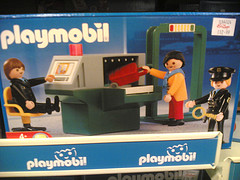I recently had a security issue with a big retailer (who shall remain nameless). They emailed me that an item I had bought with my debit card was ready for pickup. Only problem was, I was camping when it was purchased – not in their store or online at their site.
My wife was confident our card had been stolen. I thought maybe they had somehow back ordered something for us that we hadn’t actually wanted.
I called them, venturing through the jungle of their voicemail system, put on hold, hung up on once, and finally was told by someone I needed to pick it up at the store and return it if I didn’t want it. I’m not sure if anyone at the store understood what was going on, but their attention was definitely on people in the store, not those on the phone.
So I went to the store. I explained the situation. They looked it up and it looked like someone had bought stuff on their own card, one thing wasn’t available, and when they put in the request to be notified they someone got me. I assume the customer provided their phone number, which was misheard, and not verified (“Mr. McCormack?”). No charge to my card. No data stolen or anything.
They said sorry and said they’d look into the issue and correct it.
Was that it? I wasn’t holding out for a freebie, and the sooner I could get out of there the sooner my 19 month old son would be happy, but it seemed like they really dropped the ball at that moment. While this wasn’t a horrible situation it was clearly a big waste of my time, and it made their security practices look bush league. They didn’t seem to even know that I had called.
This was their opportunity to say we’re sorry we wasted your time, here’s a $10 gift card, or whatever. Instead, nothing. Their competitor is across the street. They didn’t even try to keep me.
- Have a security policy.
- Make sure security and customer service are a priority and that your employees feel ownership to do whatever they need to protect and serve your customers.
- Acknowledge mistakes and try to make it up to your customers.
- Reward your employees for their efforts.
- Suggest improvements to your employees – don’t bust them for doing too much, only for doing too little.
- If you track customer interactions actually use that data.
- Share experiences with employees so they know what to and what not to do.


